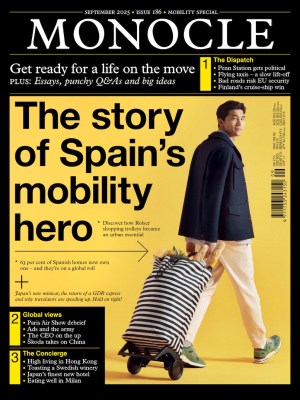Airports have long suffered from an identity crisis. Are they public infrastructure or luxury malls with departure boards? Should we think of them as civic gateways or as necessary evils to endure while en route to somewhere better? For most travellers, it’s a place associated with queues, poor signage and hours lost to bureaucracy. But Paul Griffiths, the long-serving CEO of Dubai Airports, has a fresh idea – and when he starts to share it, he lights up.
Leaning forward in his chair, he tells us about his vision of an airport that doesn’t ask for your passport, make you queue for security or hold you hostage at a baggage carousel. “You just turn up, pass through, drop your bag and walk straight onto your plane or into the lounge,” he tells Monocle, “No friction. No stress.”
Griffiths comes across as a Willy Wonka of global aviation, sketching out the blueprint for a kind of golden-ticket experience that few of his peers would dare to even imagine. On one wrist, he wears a sleek fitness tracker; on the other is a chunky, two-tone timepiece that catches the light. It’s an apt pairing of precision and polish – much like the aviation ecosystem that he’s trying to build.

“Why are we still sticking paper tags on suitcases?” he asks incredulously. “It’s demeaning. Bags should be manufactured with a unique serial number, with barcodes printed on. You should be able to track your luggage anywhere in the world and it should be delivered directly to you or to the transportation waiting for you outside the terminal. No more carousels. No more waiting around.”
This isn’t a mere fantasy. In Dubai, some of it is already happening. Biometric systems now let passengers pass through immigration using facial recognition, without the need for a passport scan. “The technology is here,” says Griffiths. “What’s holding us back isn’t the tools. It’s human hesitation.”
All of this might sound evangelical. But in Dubai, where major infrastructure gets approved and built in a fraction of the time that it takes elsewhere, it isn’t just optimism. “When I first arrived in 2007, Emirates had just ordered 80 A380s,” says Griffiths. “Sheikh Ahmed bin Saeed Al Maktoum [CEO of Emirates Airline] said one thing to me: ‘Do not constrain the growth of aviation.’ So we got to work.”
Dubai International’s passenger capacity has grown from 32 million a year to more than 92 million today; it has been the world’s busiest international airport for 11 consecutive years. “We have achieved that with less than half of the staff that we had back then,” adds Griffiths. “We went from 3,600 to 1,700 people. We’ve had to be more productive, more efficient and more collaborative with our partners than almost any other airport.”
That ruthless efficiency now feeds into the development of Dubai’s next big leap: the expansion of Al Maktoum International, a new airport expected to eventually handle 260 million passengers a year. On paper, that number sounds almost absurd – it’s larger than the populations of most countries. But Griffiths is already thinking beyond the scale.
“We want it to feel small – not like a huge, monolithic terminal,” he says. “I don’t want people to feel that they’re in an airport. I want them to feel as though they’re simply moving.” The plan involves having several smaller, self-contained terminals – “nodes” – linked by high-speed rail. “Think of it as eight perfectly designed mini airports, stitched together. We can use AI to optimise passenger flows. If 100 people on a flight are transferring to another, the system should direct that aircraft to a gate nearby, reducing walking distances.”
If Griffiths sounds like a futurist, he’s also a pragmatist. He is frustrated by what he perceives as the inertia plaguing his industry. “So many airports are still being designed around outdated processes,” he says. “Even when they build new infrastructure, it’s wrapped in the same old rules. We used to design buildings and retrofit technology. Now we need to do the opposite: design buildings around the technology that we want.”
He points to the dehumanising experience of modern travel: the security shuffle, the repeated document checks, the slow-moving queues. “It’s like we’ve forgotten that customers are human beings,” he says. “The industry has accepted mediocrity. Staff aren’t motivated. Passengers aren’t respected. And most airports, especially in Europe and North America, seem to have given up trying.”
That makes Dubai an outlier but Griffiths sees his role as more than just running an efficient operation. He considers Dubai Airports to be a global prototype. “All we can do is lead by example,” he says. “If our ideas are copied by others, that’s fantastic. This isn’t about winning. It’s about improving the experience for travellers everywhere.”
The real breakthrough will be in reducing the time that things take. “I’ve never met anyone – apart from a few aviation nerds – who actually wants to spend more time in an airport. People would rather get where they’re going. So why are we still telling people to show up three hours early? That should be a thing of the past.”
If Al Maktoum International hits its 2032 target, traffic will start being moved from Dubai International to the new site – a big migration that Griffiths acknowledges will be “an extraordinary logistical challenge”. But he’s confident. “We’ve opened every terminal in Dubai on time and without fuss. We intend to do the same again.” And what becomes of Dubai International, the current crown jewel? “That’s for the government to decide,” he says. “But the development potential is enormous. Think of what Hong Kong did with the old Kai Tak airport. This land could reshape the city.”
Griffiths, now approaching 50 years in the aviation industry, isn’t ready to step away just yet. He is still energised by the challenge. “We must stop thinking incrementally,” he says. “If Google, Amazon and Uber reimagined entire industries, why can’t we do the same with airports? After all, the future’s here. We just need to walk through it.”



